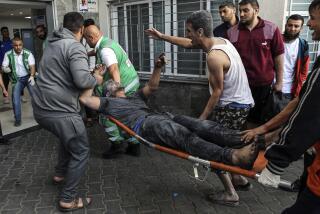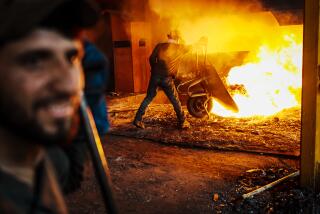Tet ‘68, Kabul ‘12: We still don’t get it
Recently, after Afghan militants unleashed sophisticated, synchronized attacks across Afghanistan, including in the capital, Kabul, the Pentagon was quick to emphasize what hadn’t happened.
“I’m not minimizing the seriousness of this, but this was in no way akin to the Tet offensive,” said George Little, the Pentagon’s top spokesman. “We are looking at suicide bombers, RPG [rocket-propelled grenade], mortar fire, etc. This was not a large-scale offensive sweeping into Kabul or other parts of the country.”
Defense Secretary Leon Panetta weighed in similarly.
“There were,” he insisted, “no tactical gains here. These are isolated attacks that are done for symbolic purposes, and they have not regained any territory.”
Even granting the need to spin the assaults as failures, the official American reaction to the coordinated attacks reveals a fundamental misunderstanding of guerrilla warfare in general and of the type waged by the Haqqani network in particular. It’s a lesson the United States should have learned decades ago.
But more than 40 years after the Vietnam War’s Tet offensive, after more than a decade of war in Afghanistan, theU.S. military still doesn’t get it.
When Vietnamese revolutionary forces launched the 1968 Tet offensive, attacking the South Vietnamese capital of Saigon as well as four other major cities and nearly 150 other sites, they were hoping to spark a general uprising. What they did instead was give the lie to months of optimistic talk by American officials about tremendous strategic gains and a foreseeable victory.
Just months before Tet, the top U.S. commander in Vietnam, Gen. William Westmoreland, had claimed there was a successful end in sight for America’s war. So how, then, were the Viet Cong able to launch such a widespread assault?
In the course of the offensive, some 58,000 revolutionary fighters were killed, and their advance was beaten back. But guerrillas the world over grasped the lesson of Tet: It is crucial in a guerrilla war to highlight your enemy’s vulnerabilities, its helplessness to stop you — and it doesn’t have to take 58,000 lives to do that.
The Haqqanis lost only 39 in their recent attacks. And they demonstrated conclusively that they are living in 2012, in global war-making terms, while the Pentagon, in a sense, is still stuck in the mind-set of Saigon, 1968.
Panetta noted that the Haqqani fighters had not taken territory. But that wasn’t the point. What territory, after all, could the Haqqani militants have been out to regain by attacking Kabul’s heavily defended diplomatic quarter? The German Embassy? And then what would they have done? While Panetta at least granted that the attacks were geared toward symbolic effect, he remained strangely focused on their tactical significance.
As in Vietnam, theU.S. militaryin Afghanistan regularly attempts to prove that it’s winning via metrics. We get reports of enemy captures and body counts, as if the conflict can be won on points, like a boxing match.
In the Vietnam years, Westmoreland and other top U.S. officials were forever seeking an elusive “crossover point” — the moment when their Vietnamese foes would be losing more fighters than they could replace and so would have to capitulate. America would win by fighting a war of attrition.
But that didn’t work in Vietnam, and it’s not working in Afghanistan. More than a decade after U.S. forces swept into Kabul, what began as a ragtag remnant insurgency has grown stronger and continues to vex the most destructively powerful, best-funded military on the planet. All of America’s tactical gains and captured territory, especially in the Taliban heartland of Helmand province in southern Afghanistan, haven’t brought the country anywhere near victory.
As the Haqqanis clearly meant to underscore with their recent coordinated attacks, America’s trillion-dollar military, in conjunction with hundreds of thousands of allied Afghan security forces, still is incapable of fully securing even a small “green zone” in the heart of the Afghan capital, much less the rest of the country.
The conflict in Afghanistan began with its American commander declaring, “We don’t do body counts,” but a quick glance at recent U.S. military press releases touting supposed high-value kills or large insurgent body counts indicates otherwise.
As in Vietnam, the United States is once again betting on a war of attrition. But the enemy hasn’t bought in. Instead of slugging it out toe to toe, in large suicidal offensives, the Haqqanis and their allies have planned a savvy, conservative campaign meant to save fighters and resources while sending an unmistakable message to the Afghan population and the American public.
The attrition of U.S. support for the war is unmistakable. As late as 2009, according to a poll by ABC News and the Washington Post, 56% of Americans believed the Afghan war was still worth fighting. Just days before the Haqqanis’ coordinated attacks, that number had dropped to 35%. Over the same span, the number of Americans who are convinced the war is not worth fighting jumped from 41% to 60%. The latest Haqqani offensive is likely to reinforce these trends.
Nick Turse is the associate editor of TomDispatch.com where a longer version of this piece appears.
More to Read
A cure for the common opinion
Get thought-provoking perspectives with our weekly newsletter.
You may occasionally receive promotional content from the Los Angeles Times.










